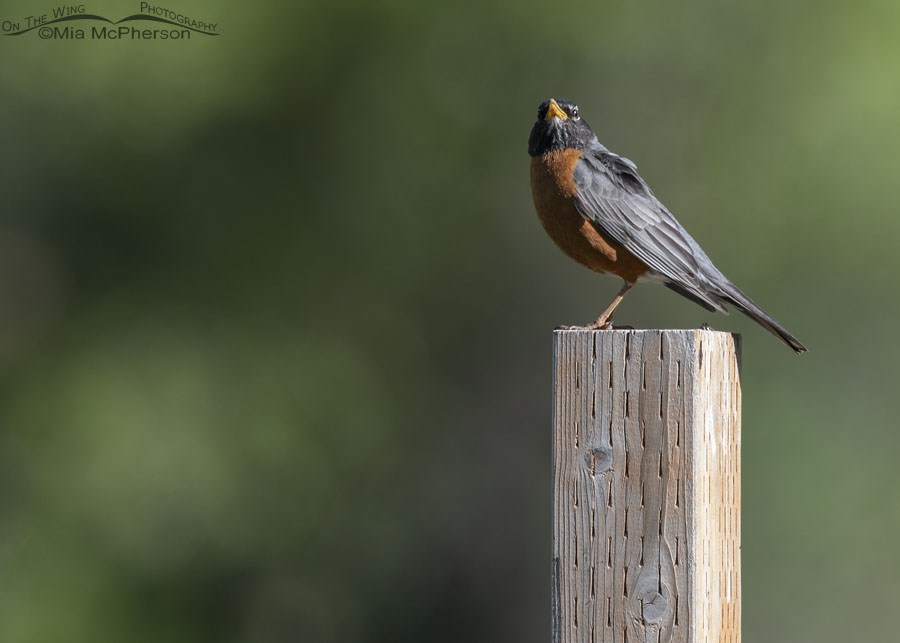 American Robin adult calling – Nikon D500, f7.1, 1/320, ISO 320, Nikkor 500mm VR with 1.4x TC, natural light
American Robin adult calling – Nikon D500, f7.1, 1/320, ISO 320, Nikkor 500mm VR with 1.4x TC, natural light
When I am photographing birds I need to find them and to do that I use my eyes, my ears and the knowledge I have stored in my brain about birds to do that. With some species of birds I often hear them before I see them so I depend on my auditory skills to locate the birds and once I do that I can usually find them with my eyes.
Cedar Waxwings are among the birds that I usually hear before I can spot them with my eyes.
The past few times I have been up in the Wasatch Mountains I have been trying to find Cedar Waxwings. Two years ago in those same mountains I was able to photograph a pair of waxwings building their nest in a hawthorn but the nest was so well tucked into the tree that I couldn’t get high quality images of them in the nest incubating or feeding their young because of the numerous branches and leaves that were blocking my view. My view of that nest became even more obstructed as the tree fully leafed out.
Last week I started hearing Cedar Waxwings again in the high mountain canyons and each time I’d hear their calls I spent some time looking around trying to find them. Some of the waxwings were simply flying by but they were too far away to photograph, some I never did see. On my last trip up to the mountains I kept listening for them.
Then I heard a single call in an open area and stopped to try to locate the bird. I looked around hoping to find the waxwing on top of a bush or shrub but the only bird in my view was an American Robin perched in top of a post. I continued to look for the waxwing I thought I was hearing and then scoped the robin with my lens (photo above, note the eye on the sky alert posture). Once I focused on the American Robin I could see that it was calling and it was making a call that sounded very, very much like the calls of Cedar Waxwings.
The high pitched “Seeeeee” call the American Robin made tricked me into thinking I was hearing a Cedar Waxwing! I was surprised because I’d never heard a robin make that specific call before.
After getting home I did some research into the call that American Robin made and found this information on Birds of the World online under Sounds and Vocal Behaviors:
A third note is a high pitched, thin, whining whistle or seet call, not unlike the call of the Cedar Waxwing (Bombycilla cedrorum; RS); this is given in response to aerial predators.
And I then had an “Ah ha” moment. No wonder I thought I was hearing a Cedar Waxwing when in actuality it was the American Robin calling out because of a predator that I did not see.
Then I spent some time trying to find a recording to share here of the call the robin made and came across a site that said this about the High Seeeeee call:
Description of Vocalization:
Very high-pitched “seeeeeee.”
Context and Meaning:
Given by males and females. This is a high-grade alarm call, usually given when a hawk is flying overhead. “Everybody! Watch out! Here comes a hawk!.”
A recording of that high pitched Seeeeee call can be listened to here.
After listening to several recordings of Cedar Waxwings and then this recording I can detect a slight difference in the calls of the Cedar Waxwings and the hawk alarm call of American Robins. Now, whether I can detect the difference in the field remains to be seen, er, um, heard.
Birds are always teaching me something new.
Life is good. Stay safe.
Mia
Click here to see more of my American Robin photos plus facts and information about this species.


SO THAT’s what that sound is!!!
Hope this little feathered teacher gets many, many chances to educate the masses.
You (and birds) often teach me new things.
Thank you.
Yes, robins make a high pitch whistle, I have heard it most often when a fledgling is on the ground or in nearby shrubs. Both the parent and the fledgling will make it to keep in contact. To me the robins whistle is a bit deeper in tone than the waxwings.
Starlings are the ones that can confuse me. they are such good mimics.
Nice
I have heard Cedar Waxwings but have only seen a Robin so figured the Cedar Waxwings were behind lots of foliage. Maybe not. Interesting!